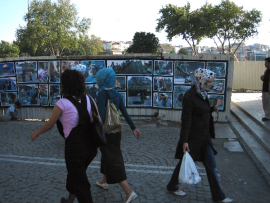
RE: Brother's photo, checkpoint borders 1 - 4
This is a series of responses to Bracha L. Ettinger: Brother's photo, checkpoint borders 1 - 4
**********
Who should have copyright on this image? Bracha L. Ettinger, his brother (who is bracha’s brother?), or the (presumed) unidentified Palestinian male who is subjected to this violence? Who owns this violence? Who owns up to this violence? Where is the intersection between our relations of property and this occupation? Even the violence bestowed upon Palestinians is not their own property? Where is the violence taking place here, in this scene? What is the role of this image in a discussion like this? What deliberations were made in allowing it to remain, to post to the list?
I have to say that this session of underfire has for me been the most staged and symptomatic of “orchestration” as opposed to moderation.
I wonder just how many posts have been refused? And what are the categories and economies of decision making which determine what stays and what goes?
Why did these images remain? What do they communicate? To whom are they intended? And just what is being represented (because maybe we should stop speaking of communication for a minute) here?
> Rene Gabri
**********
I must concur with Rene...
"What is the role of [these] images in a discussion like this?"
"Brother's photo, n.2, 2006 © Bracha L. Ettinger" "Brother's photo, n.4, 2006 © Bracha L. Ettinger" etc.
are these proclamations of ownership the statement or is it the photo or both? Does this tag of ownership also denote responsibility?
OR, Is this simply the eye of a witness or an example of the colonial gaze? Where is Bracha's voice in this dialogue? Or, where is Bracha's brother? Who is Bracha's brother?
Perhaps Bracha can clarify her intentions here...
Among other things, what is absent here are the details of the event - of the place that marks the spot where this blindfolded and bound man was sitting? Where this fence is located?
> Allan Siegel
**********
Ahem, speaking of affect, I agree with Rene Gabri. I wanted to puke when
I saw the copyright on that photo. The logic of ownership goes all the
way to the point of the soldiers gun. And it's all legitimate.
So this is yet another way that political affect circulates today.
> Brian Holmes
**********
Rene and gabri
I agree with you, I didn't think in terms of ownership but I agree
that it can look like it, so I regret it.
My idea however was the idea of testimony and not of ownership.
To be sure what I say is that
I give up in advance any ownership and any coyright.
The photo is not mine.
best
> Bracha L. Ettinger
**********
René Gabri's post opens up a question that is far reaching. To put it metaphorically: now it’s not the image of an event that counts, it’s the event of an image. Or, it’s not what happens in the image, it’s what happens to the image.
Onto a sequence of stills of the concentration camps, taken from a television network, Godard once wrote his notes: "Was it really indispensable for a national network to print its copyright logo on these poor images of the night?" The last still from the sequence is a close-up of the number stamped on the striped shirt of a prisoner... nothing needs to be added. There is an easy definition here for the technical eye of television: the technical eye is the eye that doesn’t see that logo. It is also the eye that can’t see the cut to commercials.
Serge Daney's phrase (that Brian Holmes will recognize since he translated it some 14 years ago) is to me the most precise way of describing the issue at stake with the "copyright prisoner brother's photo" : “The movement is no longer in the images, in their metaphorical force or in our capacity to edit them together, it’s in the enigma of the force that has programmed them (and here the reference to television—the triumph of programming over production—is unavoidable).”
I would also like to bring up Claire Pentecost's section on "Ownership Society" in her article "Reflections on the Case by the U.S. Justice Department against Steven Kurtz and Robert Ferrell". She opens up the spectrum of the problem of copyright in a very interesting way. In the last paragraph of that article, Claire writes "Of course it's about the art. It's about representation. The individual cases, the kinds of cases, the facts of the cases, the arguments of the cases, the numbers of cases and the distortions of those numbers, these too are very much matters of representation. The case against the Palestinians, the case against Islam, the case against pacifists, the case against independent science, the case against rural people who don't conceive of their knowledge as property, the case against all people who are in the way of the cannibalistic machine of global capital cannot only be won by force. It has to be fought in the field of representation..."
> François Bucher

